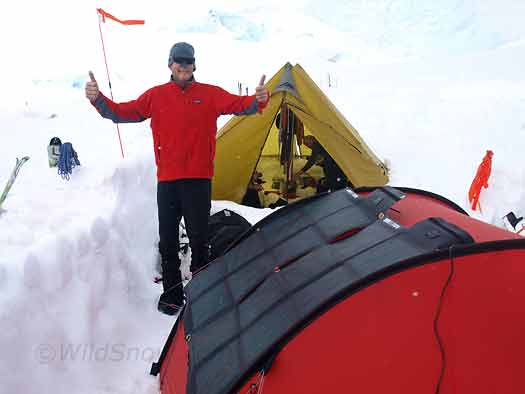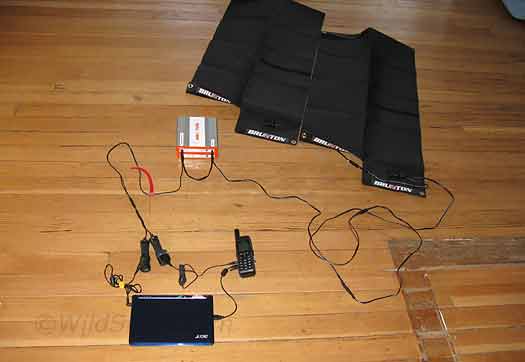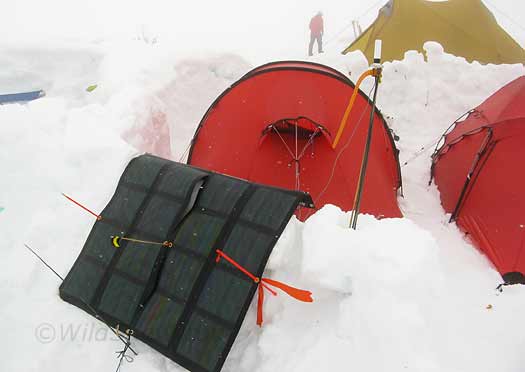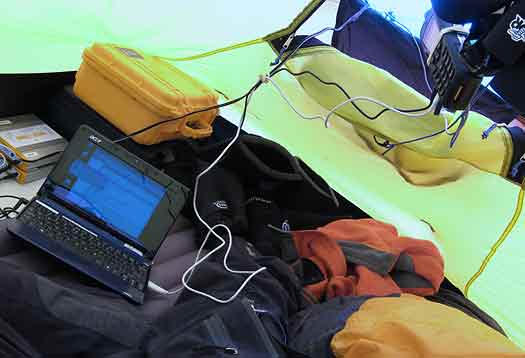Some of you WildSnow readers have been asking about our communications system here on Denali. I didn’t want to get into details before the trip because I wasn’t totally sure everything would work. But the system is doing fine after a week on the mountain now, with all sorts of temperatures, violent hauling, and several hours a day of use.

Lou gives the sign to a system that works. In our first camp we mounted the panels on the tent, but discovered they provided too much shade. We could move them around during the day for optimal angle, but we seem to have more than enough panel to leave them in one position. Keep in mind that here in Alaska we get a ton of sunlight. Indeed, we might have easily used just one panel (though the redundancy of having a pair is important.)
Because the reputation of WildSnow.com rides on blogging from the mountain, I set up the whole system with redundancy in mind, thus, two of anything critical. Two panels, two batteries, and so on. This resulted in slightly more weight, but if the system were to fail, the huge investment we’ve made in this expedition would be basically down the tubes — not to mention a lot of disappointed gear sponsors, friends, relatives and so on.
Main goal with this system was to keep costs down and still file blog posts. Many solar panel and battery options exist that would work well. In this case, with Brunton as a gear sponsor, I went with two of their folding panels and two Solo 7.5 batteries. Two Acer Aspire One computers with solid state drives and fan control software provide the brains. (Fan control is important, as you don’t want the computer trying to spin the fan when doing so is unnecessary.) I turned off as many of the computer’s internal components as possible, such as the wireless card and network card.

The system laid out at WildSnow HQ. Quite simple, really. The batteries are necessary to act as a charge reserve/controller/buffer, though most devices can be charge directly from the panels as well.
Key to our system is using the correct communications software. Iridium tries to provide their own, but it is totally lame. Better are any of the third-party companies that exist to provide efficient satphone data communications. In my case, due to financial constraints I’m having a ground person assemble and publish the blog posts after they arrive as emails from the field (rather than running a full-on internet browsing system. As far as I can tell, the best satphone email software is Uuplus — super efficient and reliable, costs a yearly fee but it’s worth it.
As for the satphone, don’t even bother with the older model Iridiums if you’re trying to do data. They have an incredibly bogus connection method. Instead, always go with the latest phone.

Our panel array at 14,200 feet on Denali. Staked out in case of wind.
Rounding out the system is the cabling and connectors. I included a number of USB ports so the boys can keep their ‘Pods charged. All the wire was heavy, so I cut and spliced nearly everything to shorter lengths.
One of the bulky heavy items in these systems is the ridiculous auto cigarette lighter plug used for connectors. I tried my best to eliminate those, but kept running up against adapters that required them, so that part of the project was a wash.
If the system is divided in half, a kit with the bare essentials weighs about 11 pounds. Total weight is around 16 lbs. Storage is in a Pelican case (heavy) for the essentials, and one lightweight inexpensive Plano brand gun case for other items (get them at Sports Authority, great value though not waterproof).

How it looks in real life inside the tent. I brought along an efficient external antenna for the satphone, so I can hang the phone anywhere in the tent and not have to worry about positioning it during calls. The external antenna also gives me more reliable connections, an issue when mountains block the horizon.
So there you go. While there are a ton of ways you can do internet comm from the backcountry these days, that’s the system we ended up with and it seems to be working great.
WildSnow.com publisher emeritus and founder Lou (Louis Dawson) has a 50+ years career in climbing, backcountry skiing and ski mountaineering. He was the first person in history to ski down all 54 Colorado 14,000-foot peaks, has authored numerous books about about backcountry skiing, and has skied from the summit of Denali in Alaska, North America’s highest mountain.

